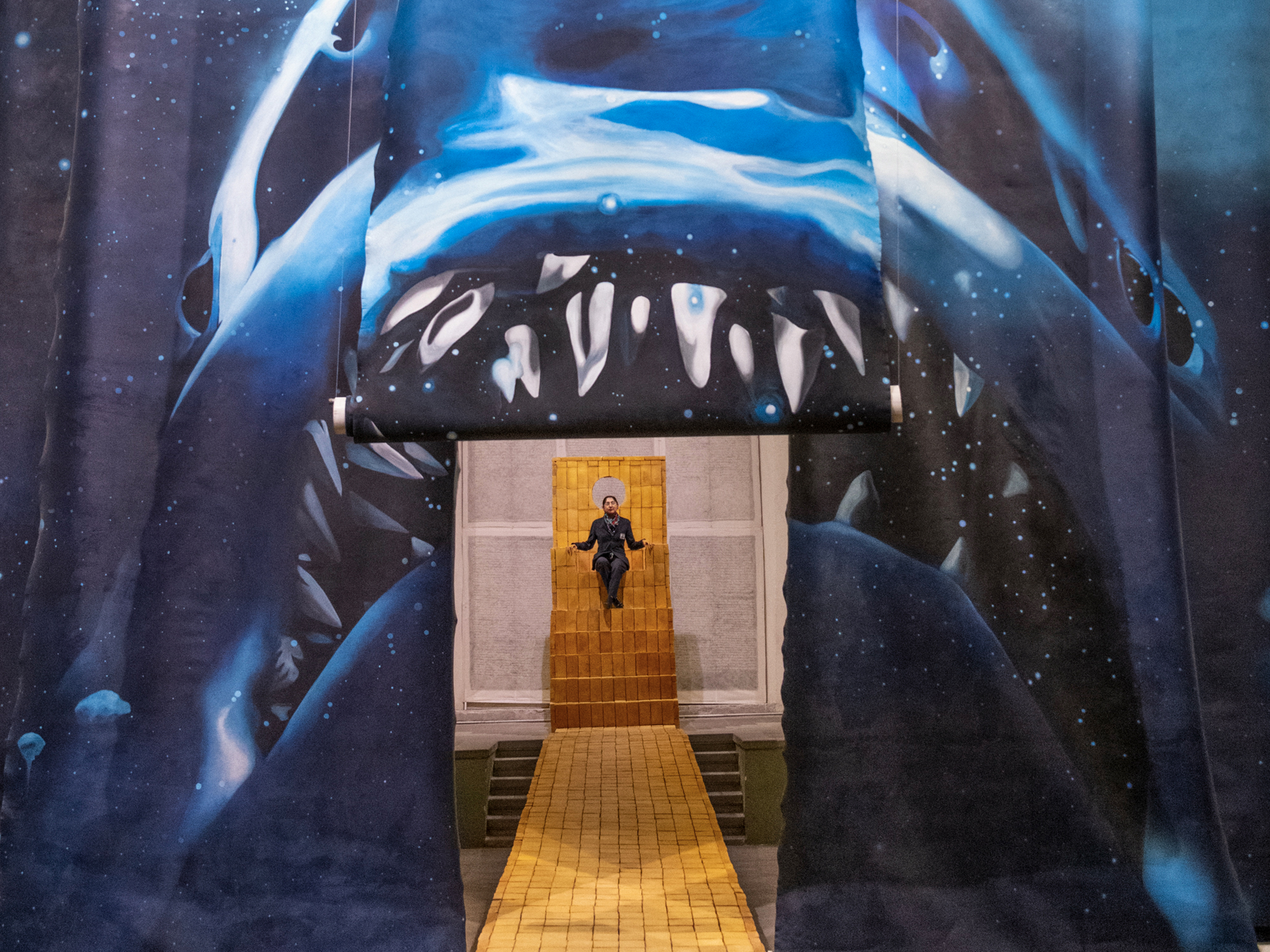
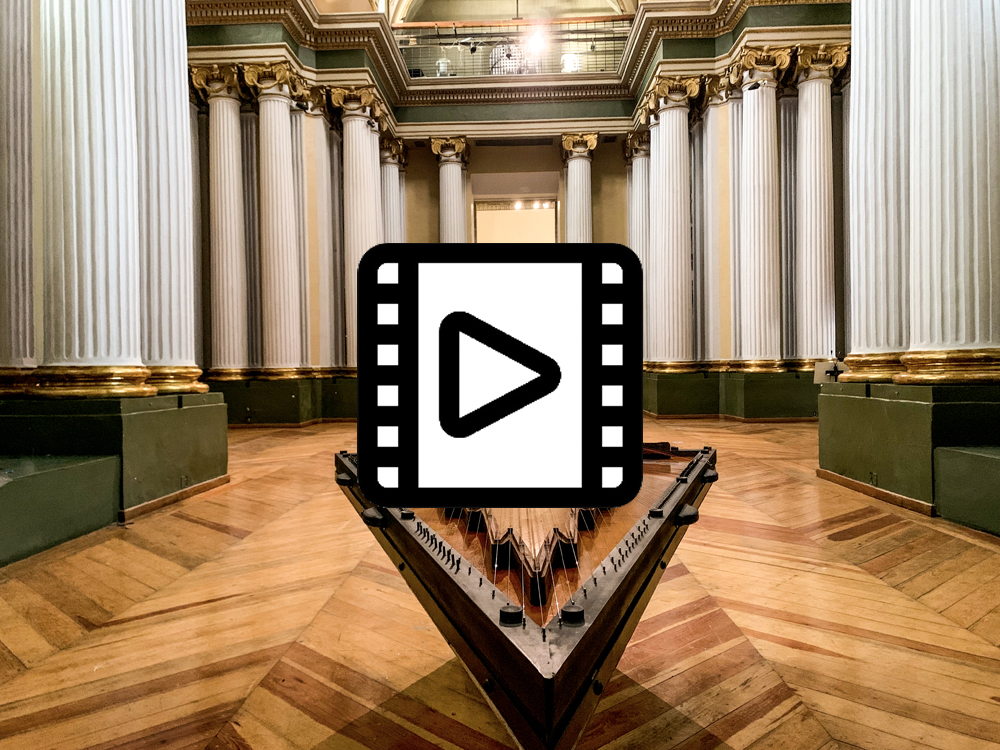
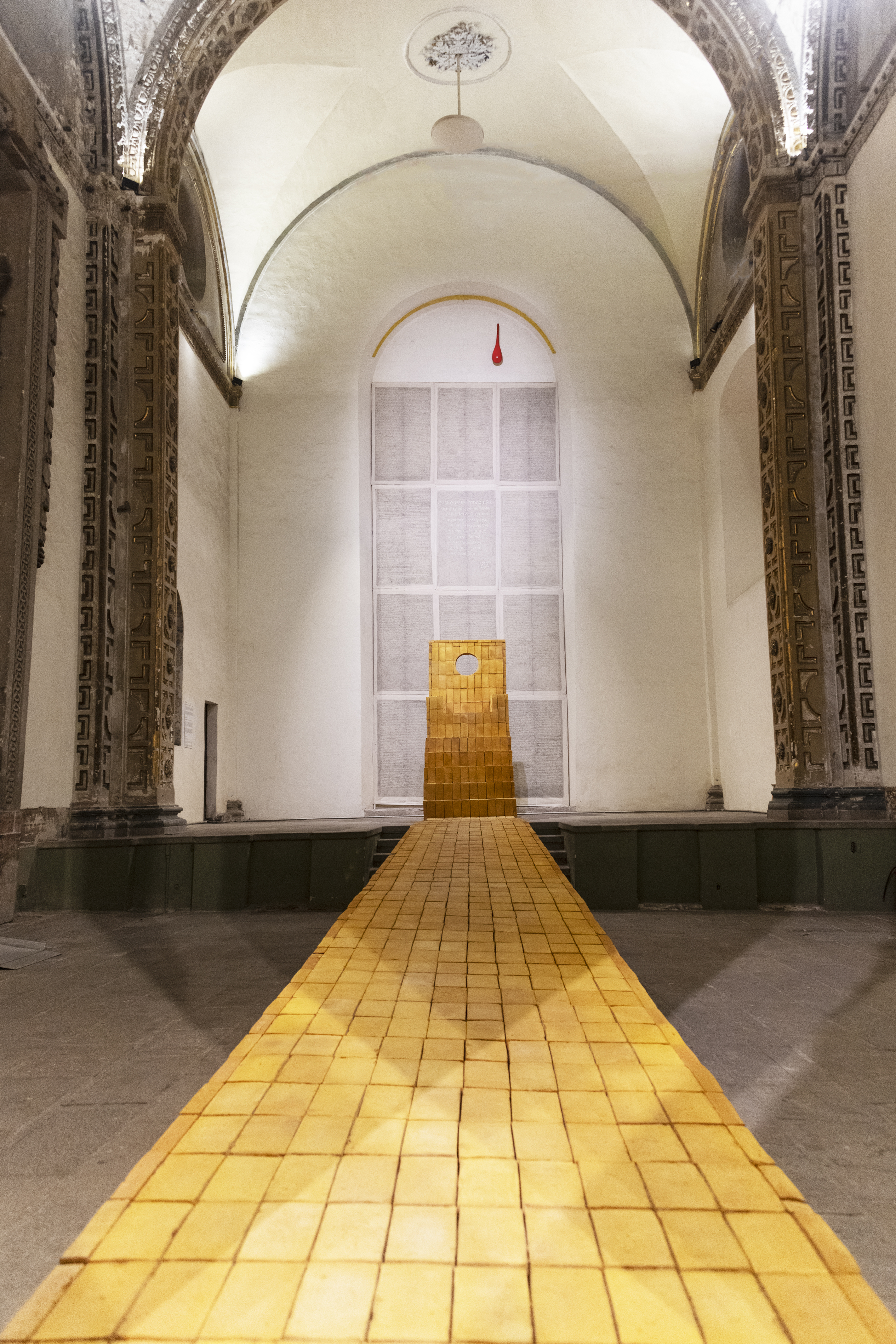
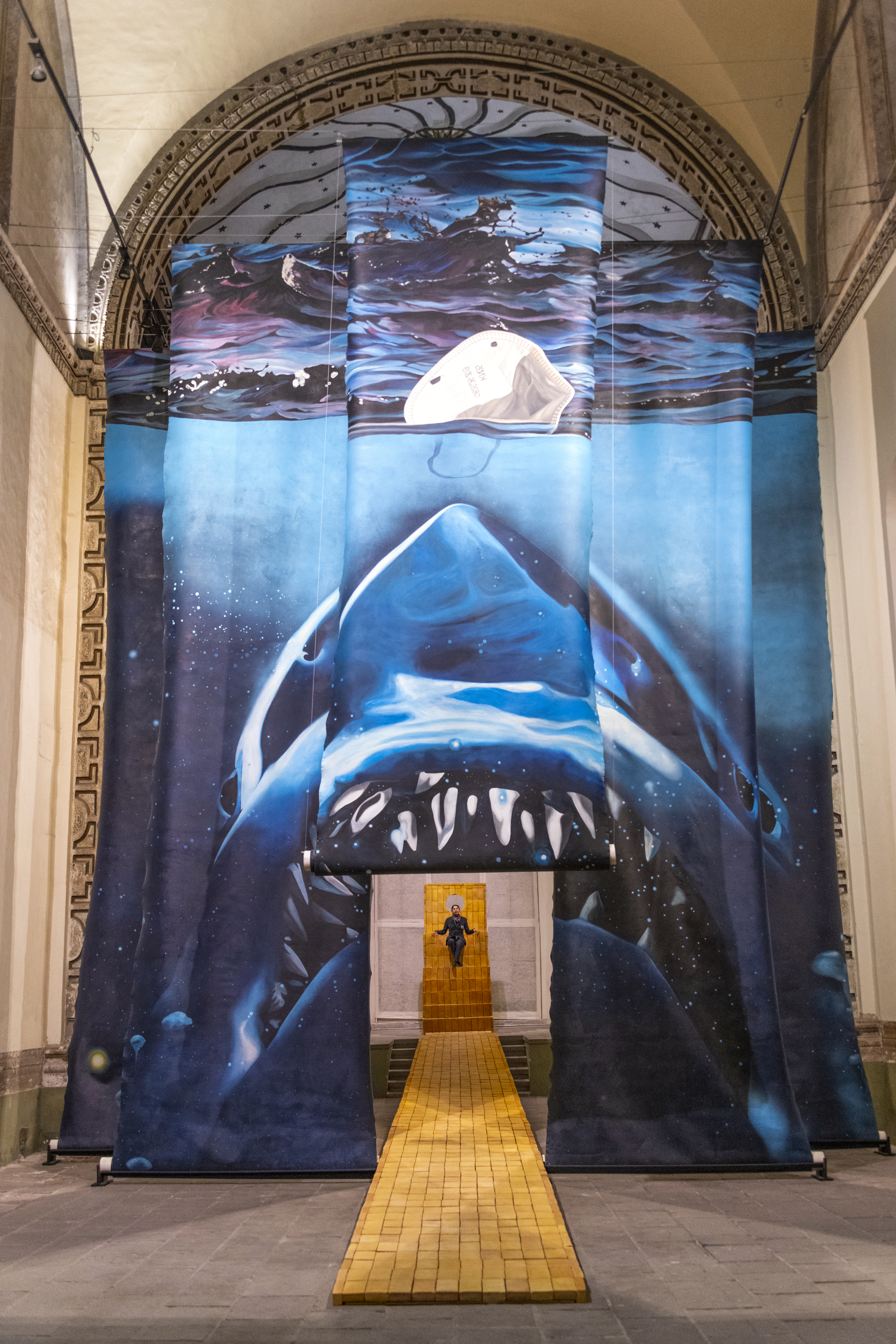
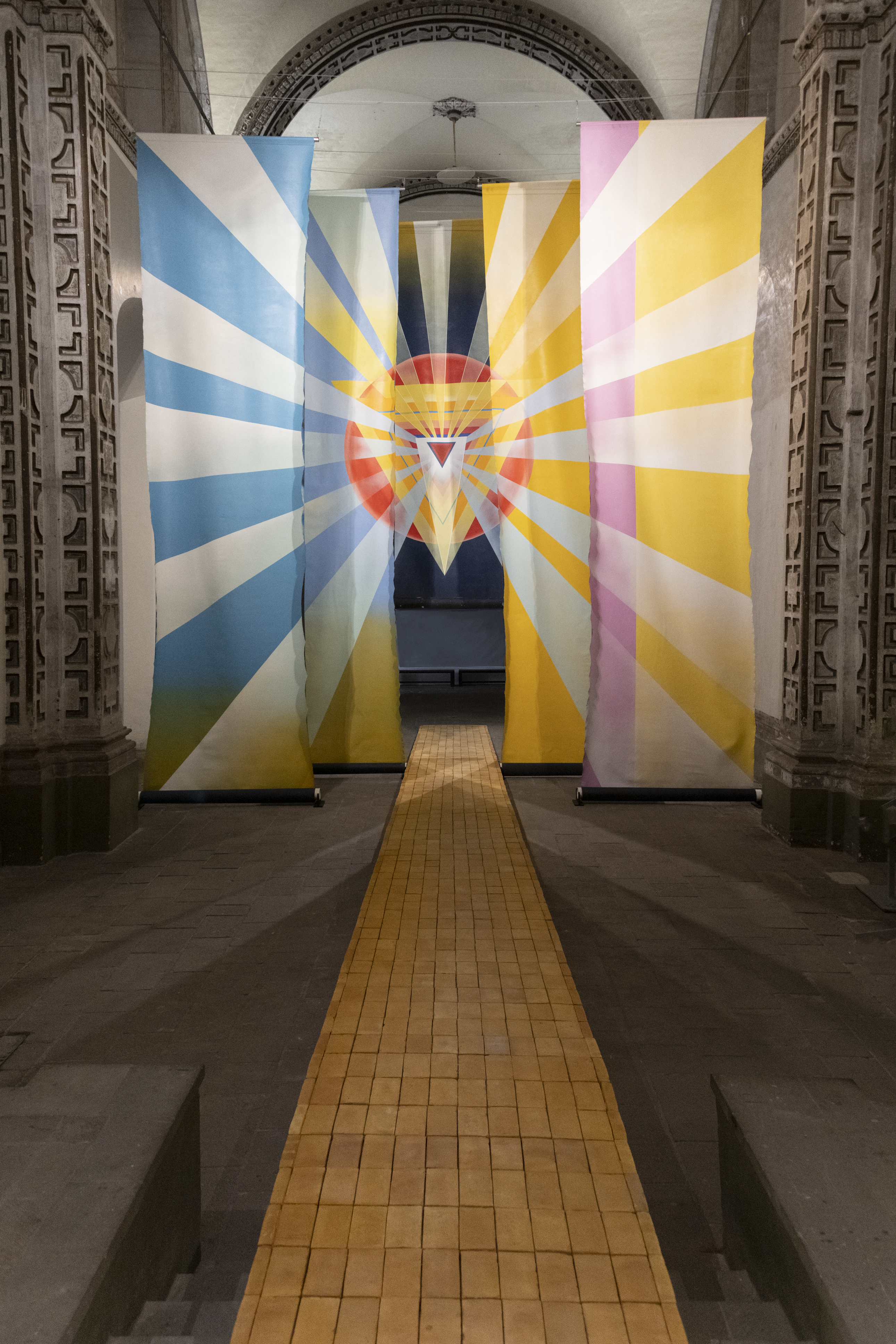
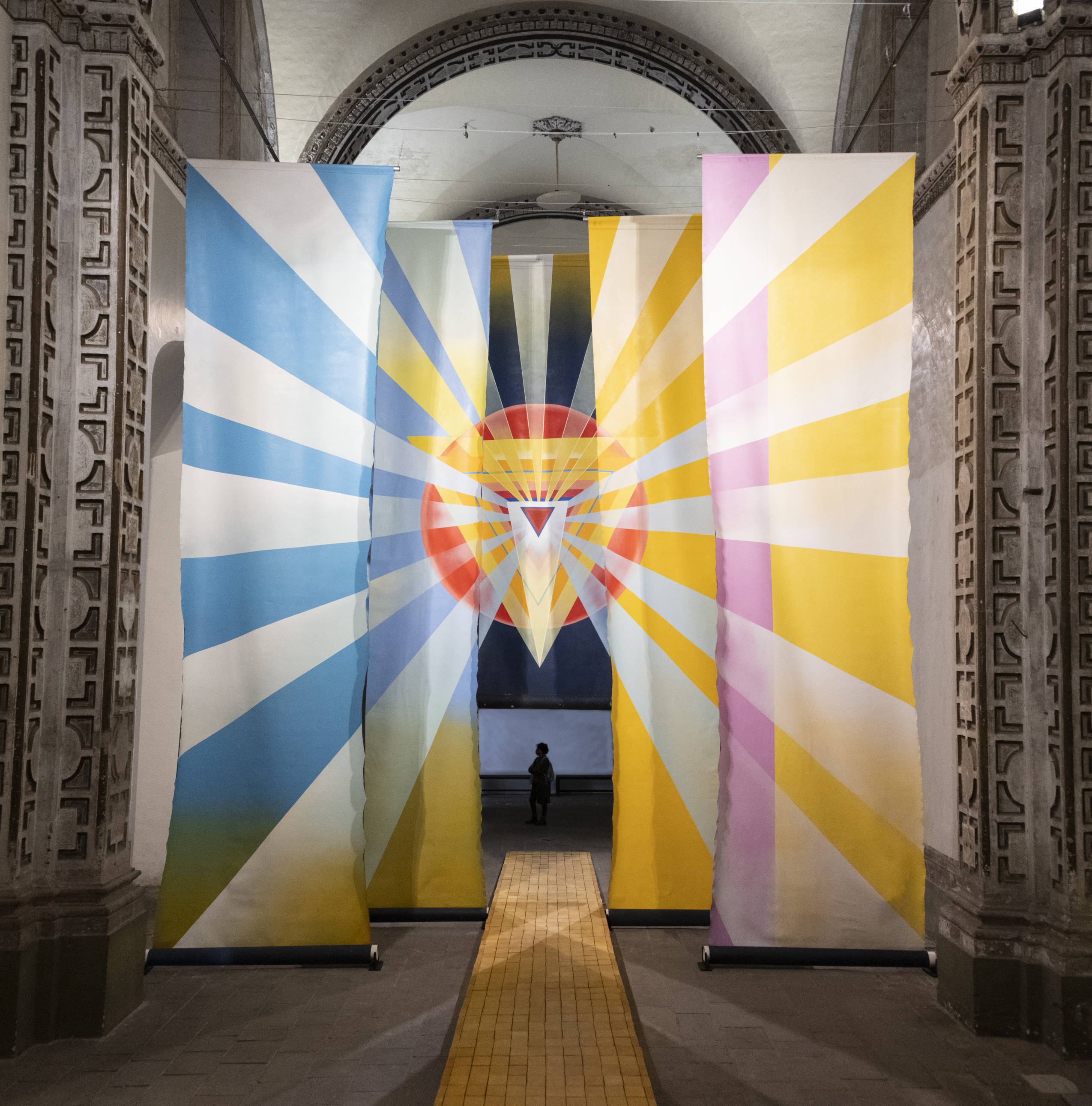
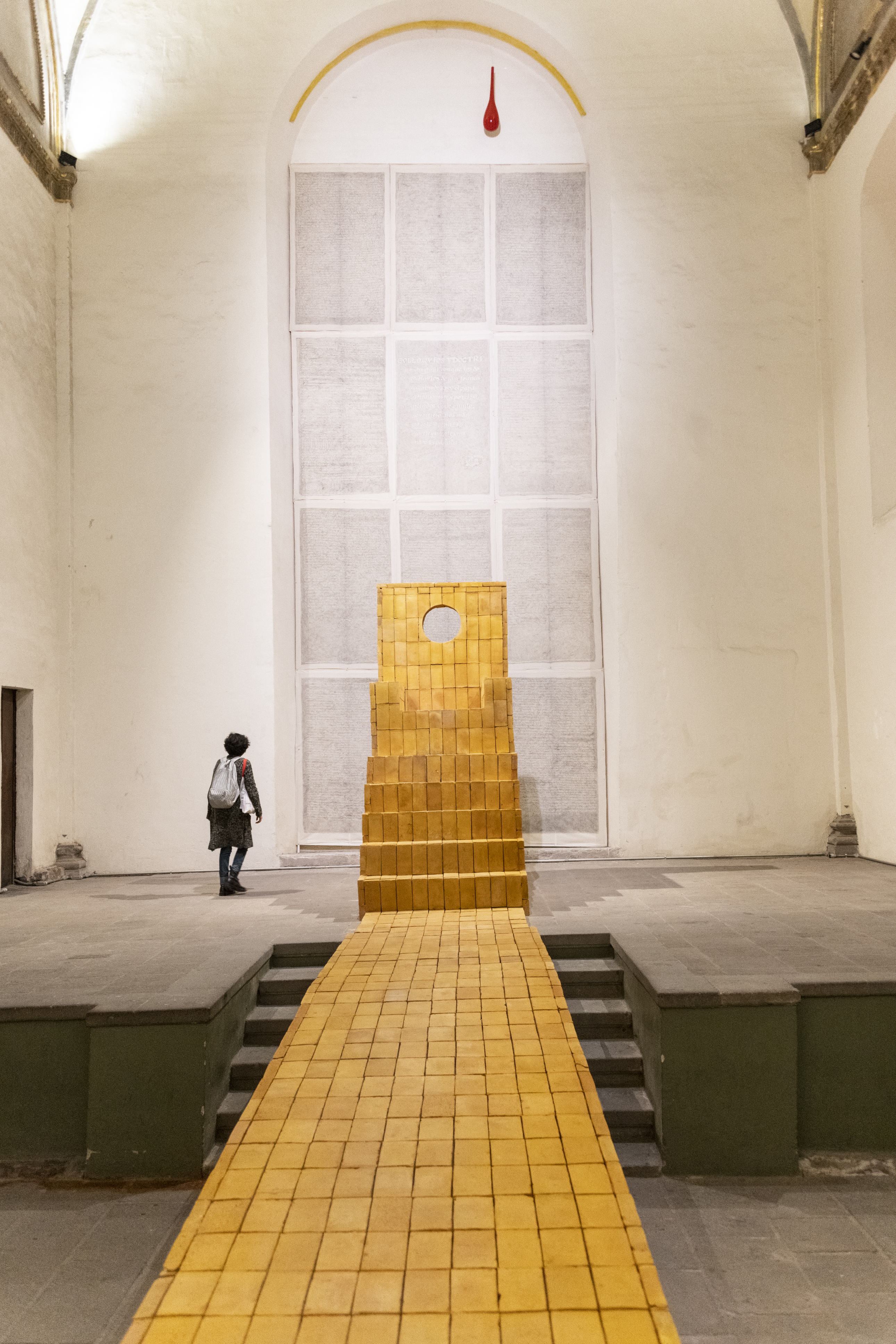
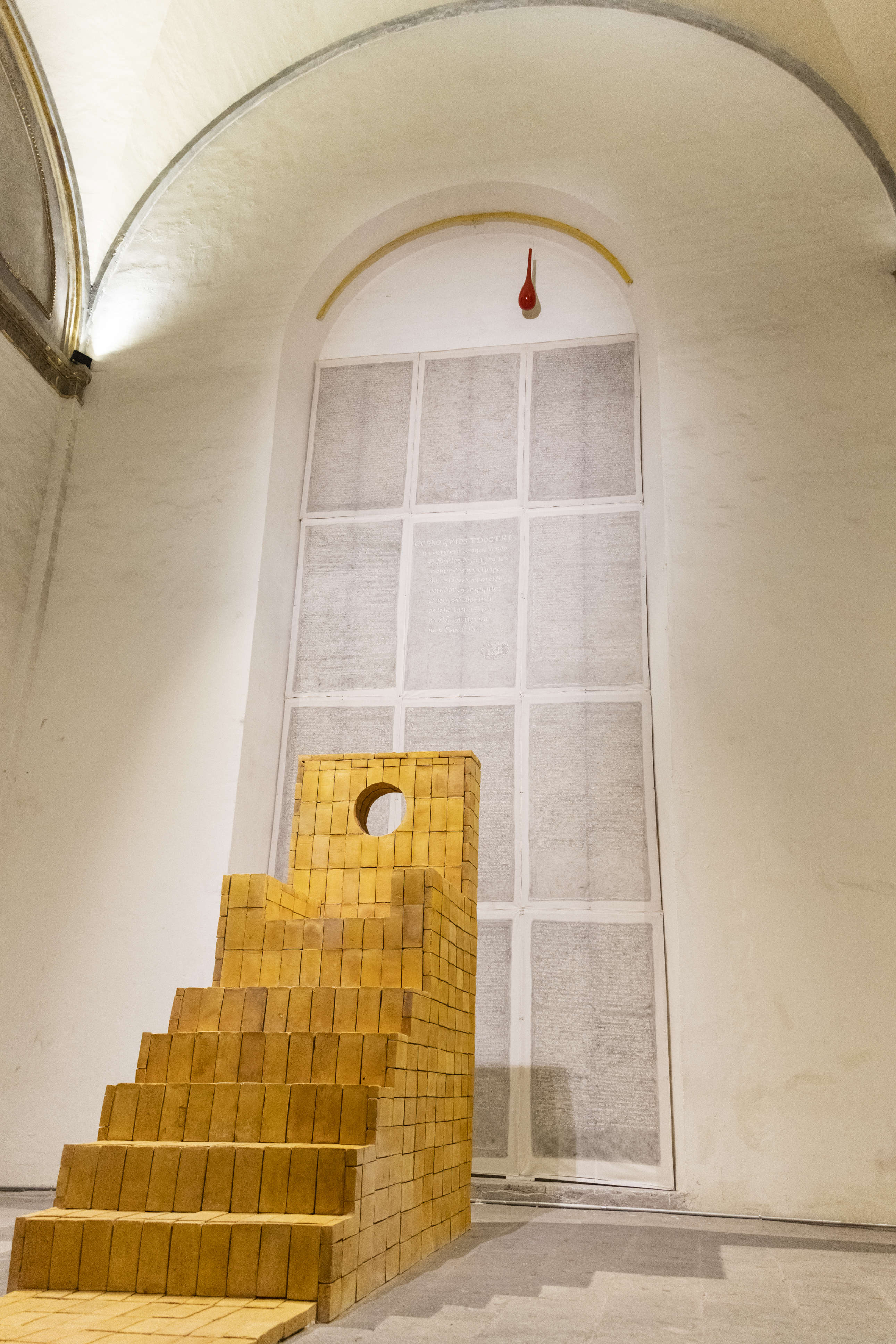
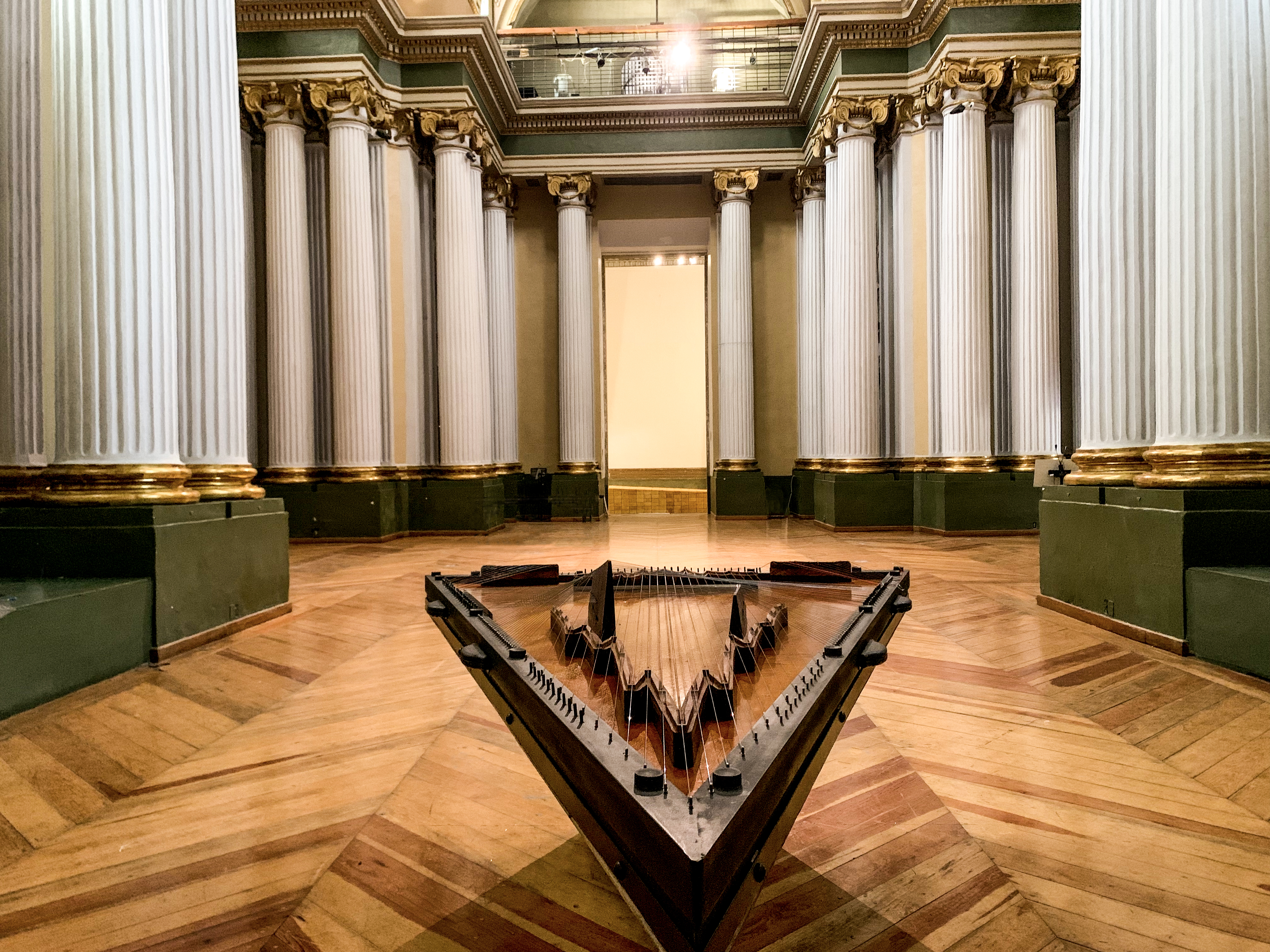
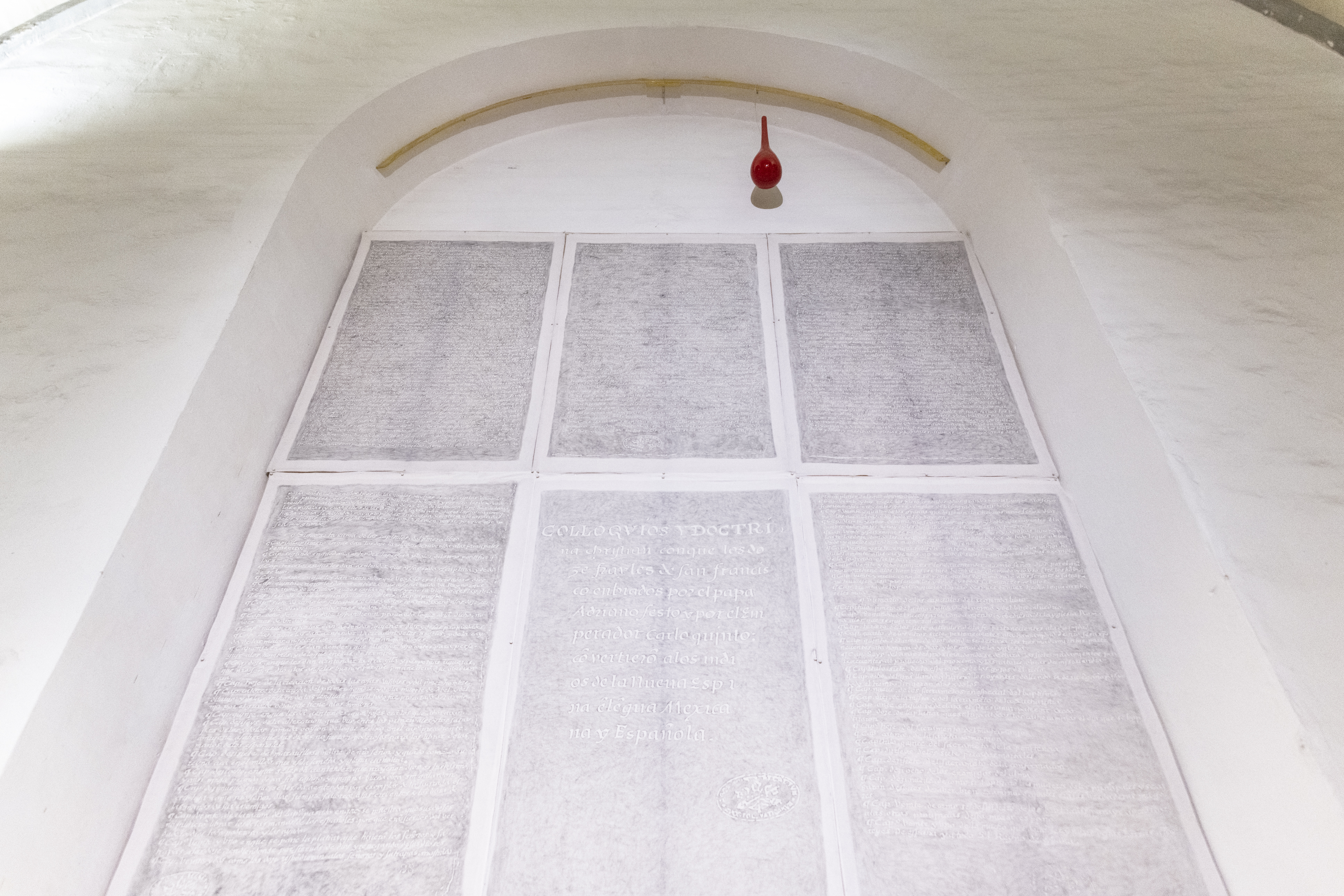
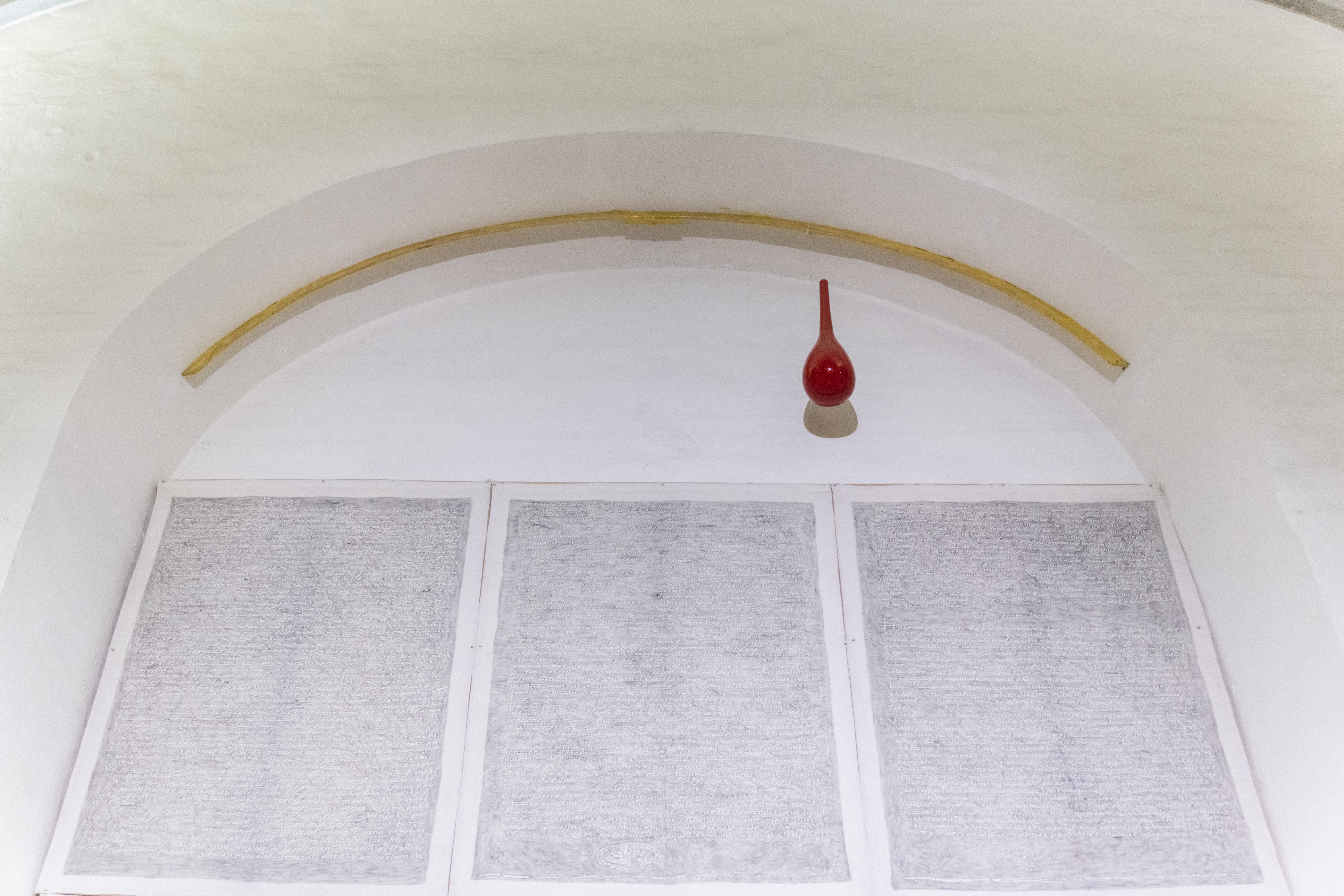
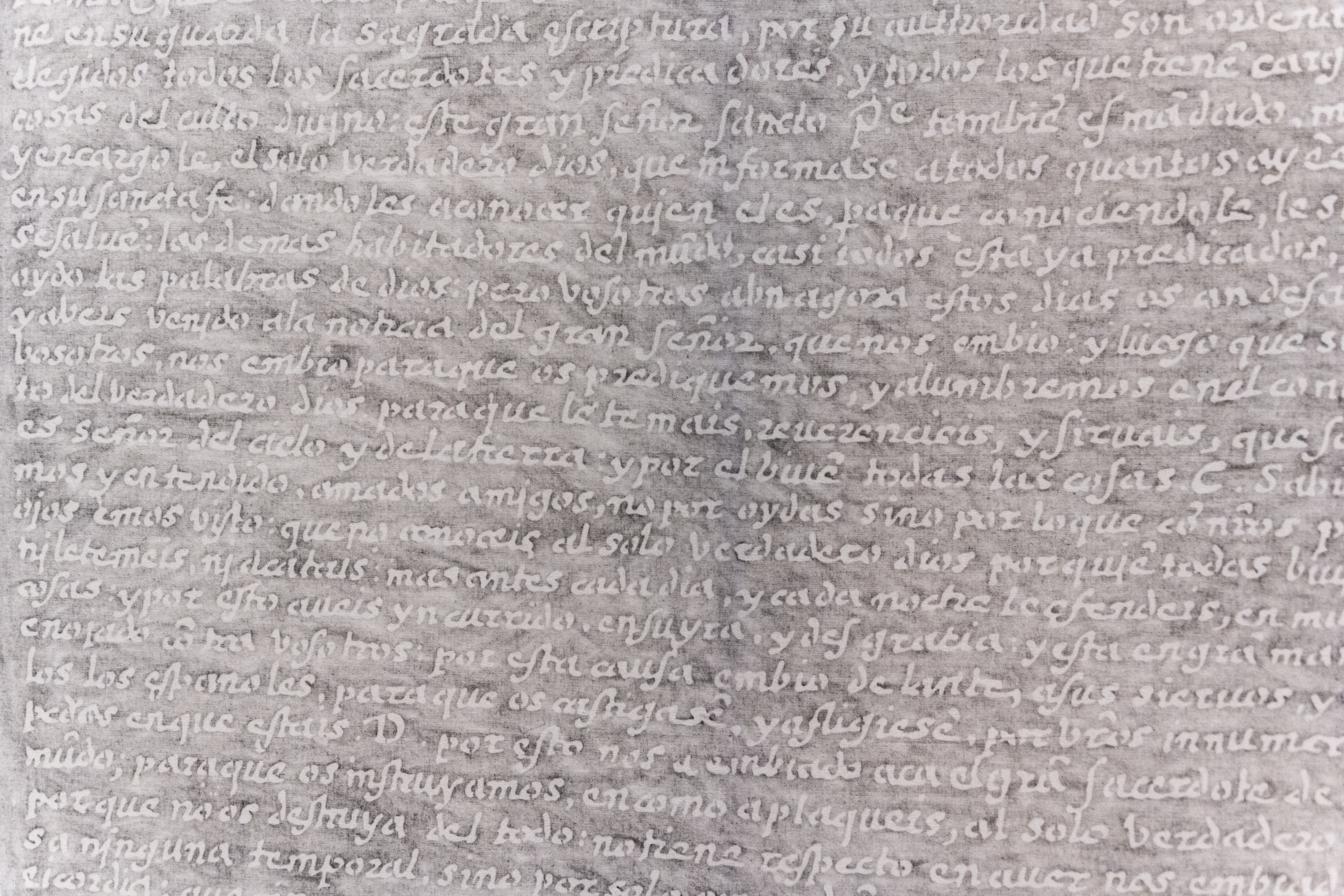
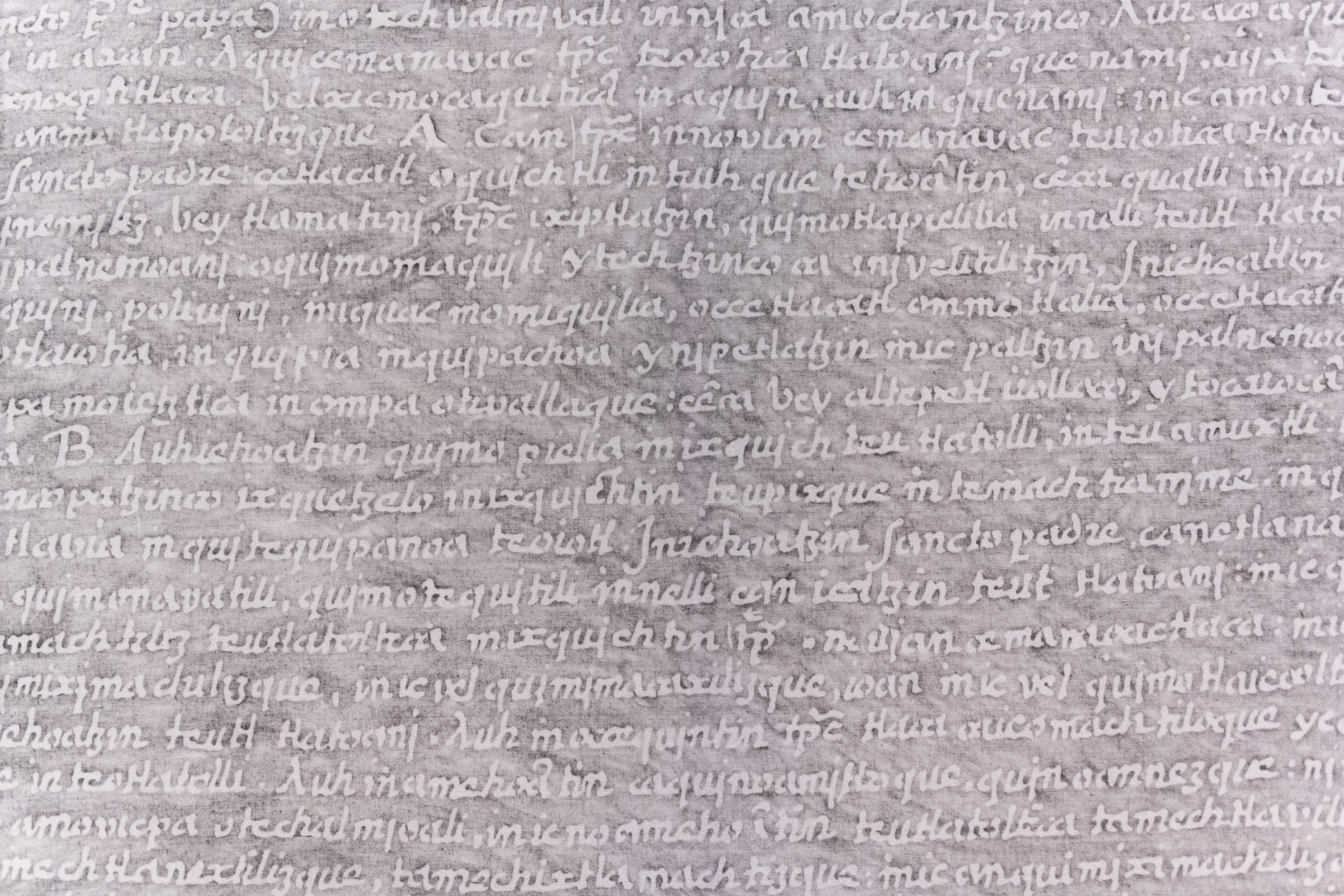
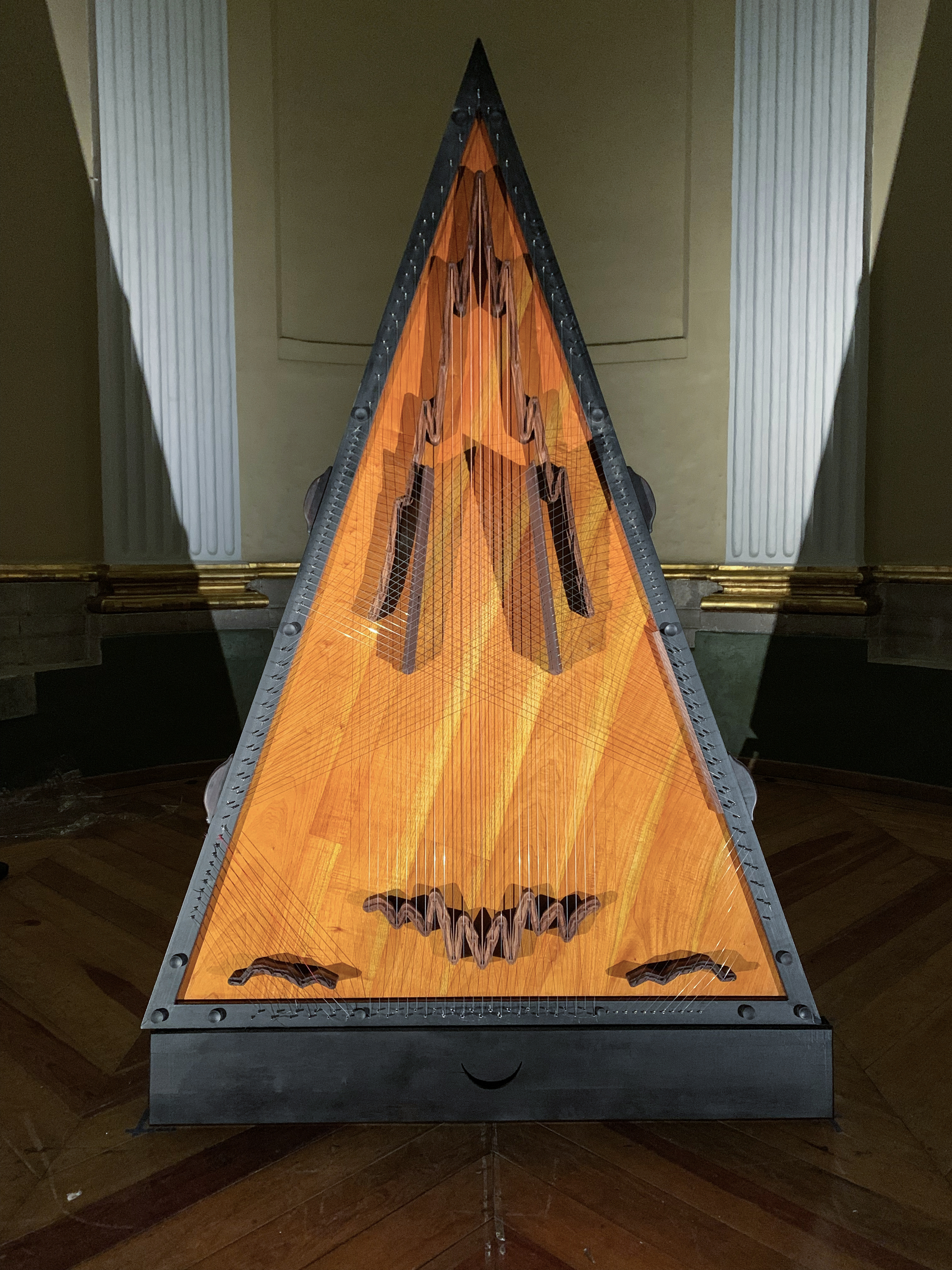
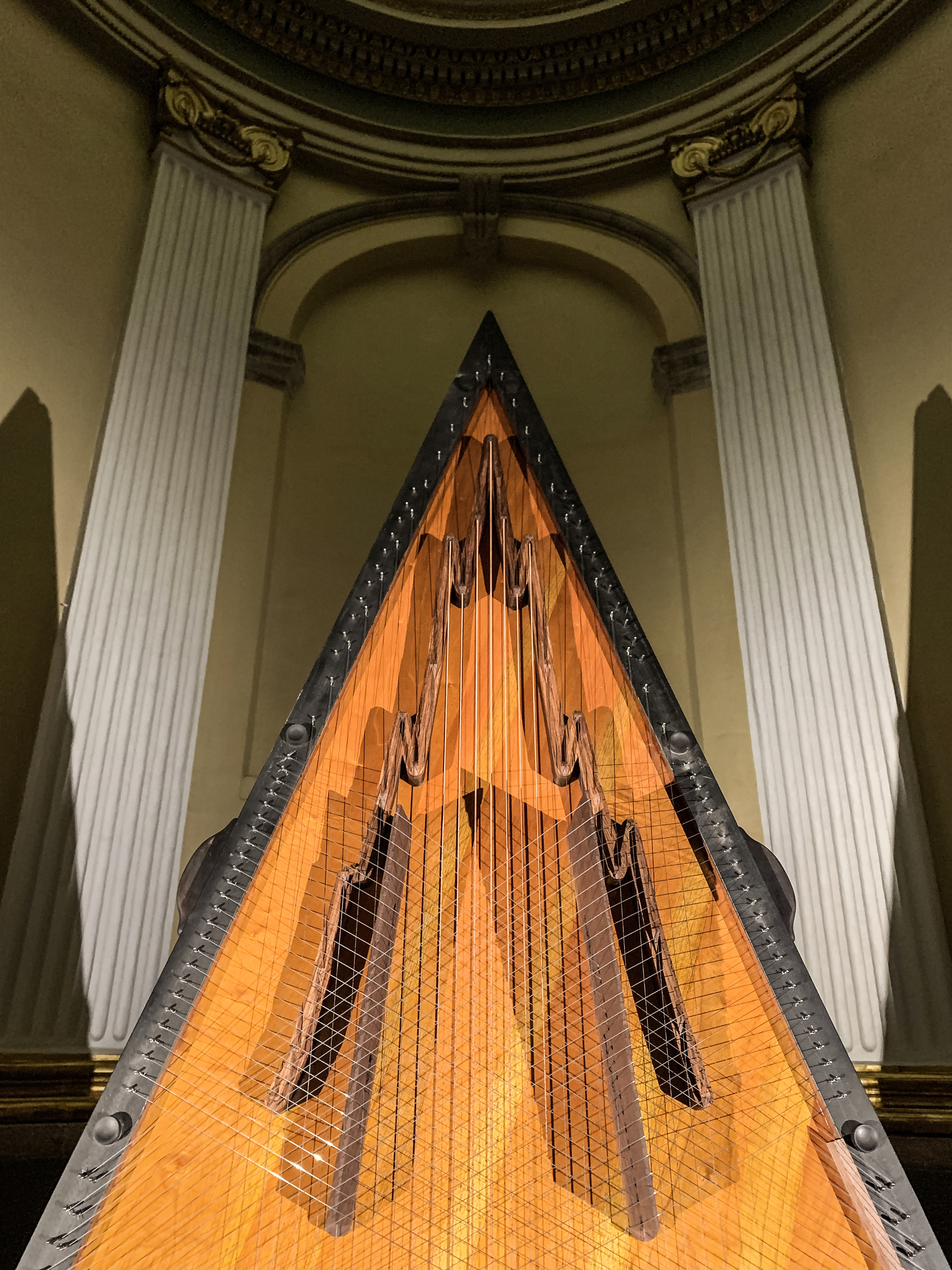
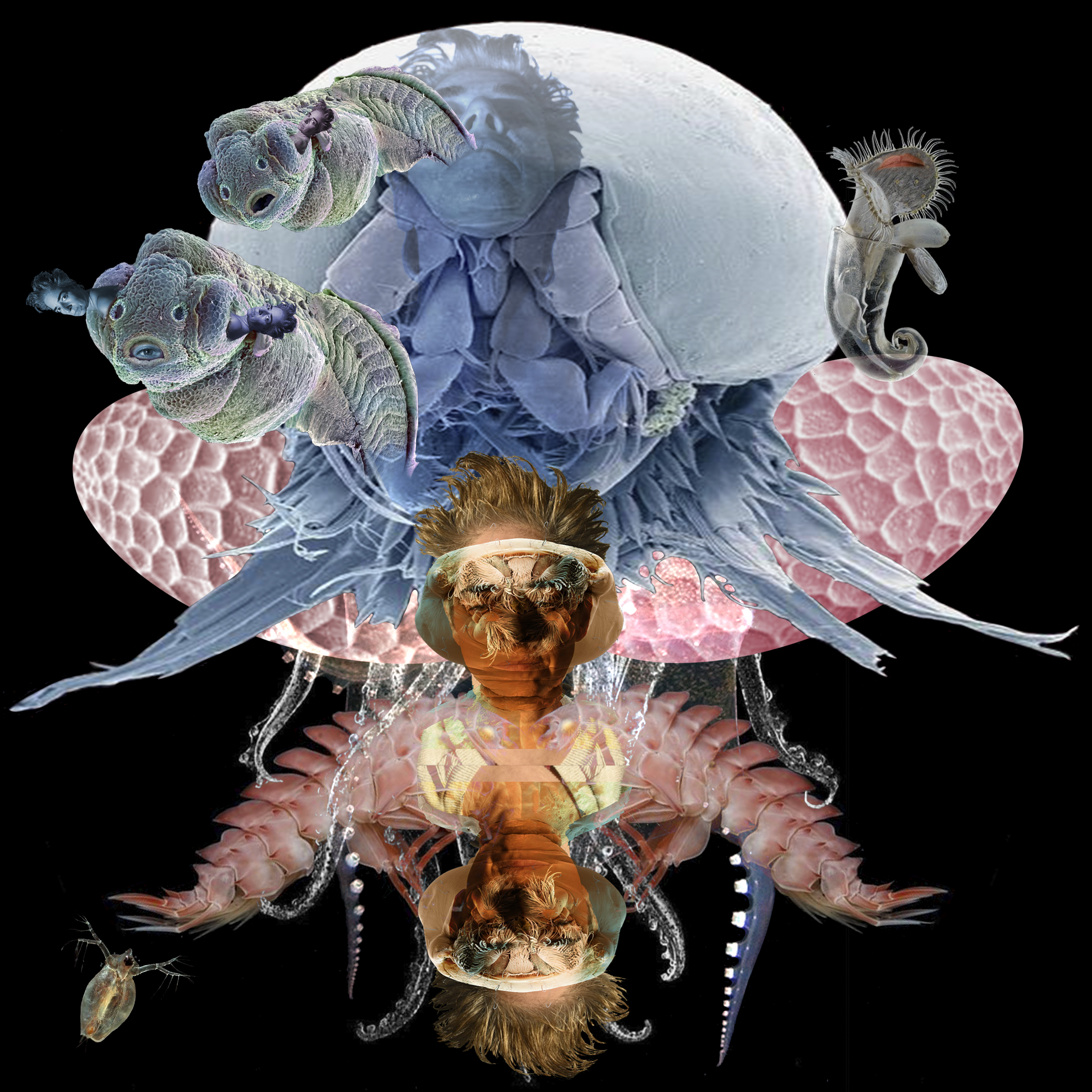
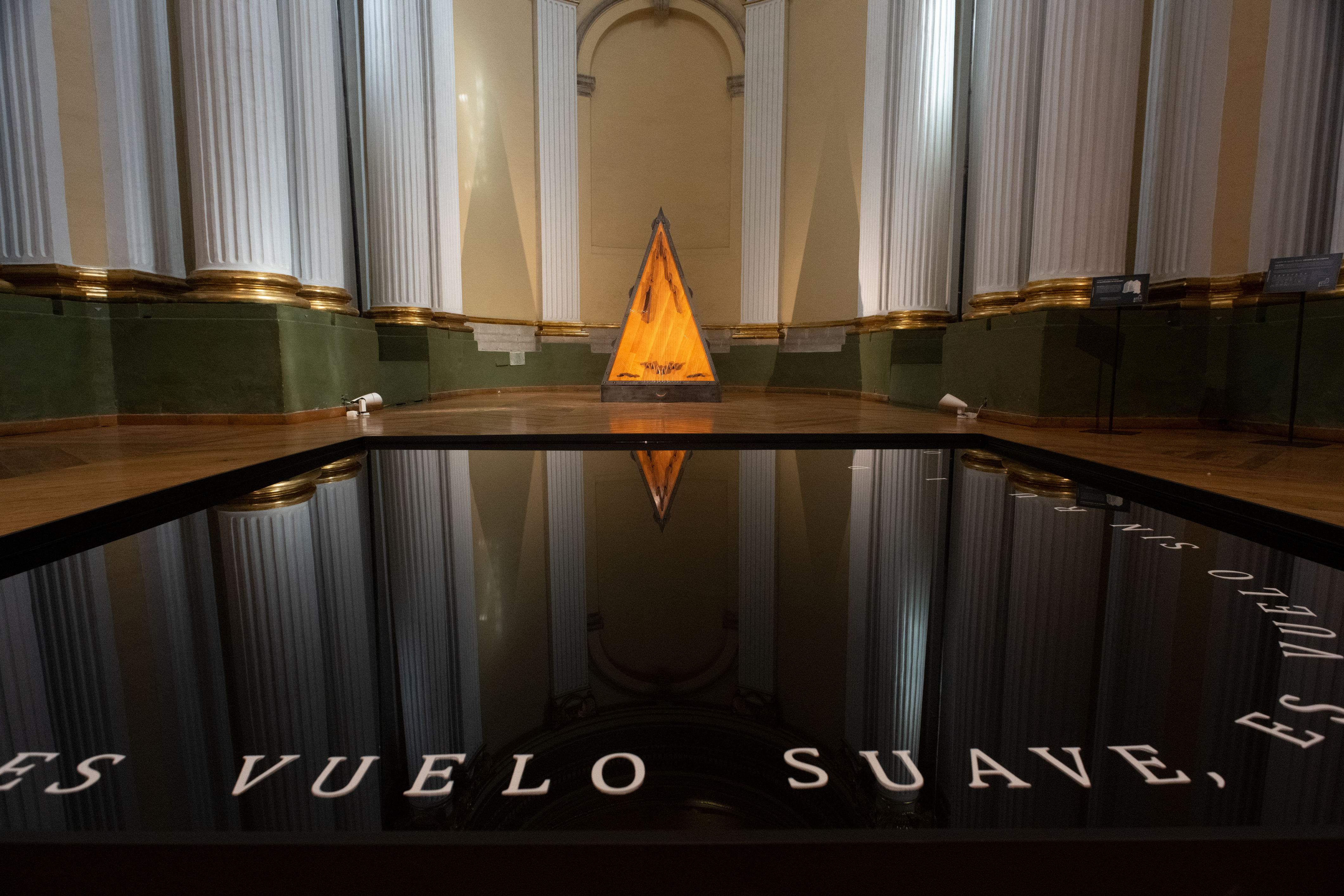
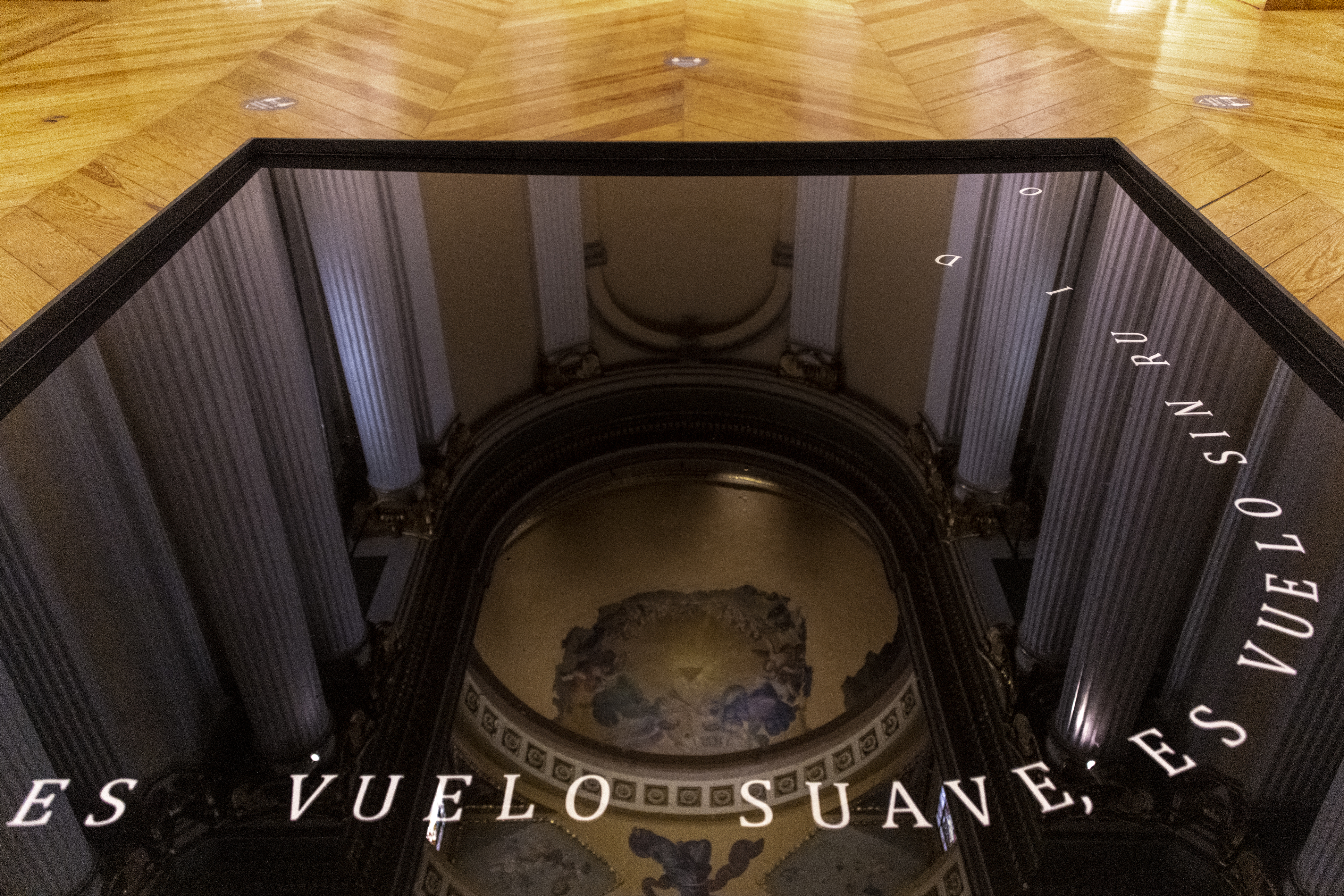
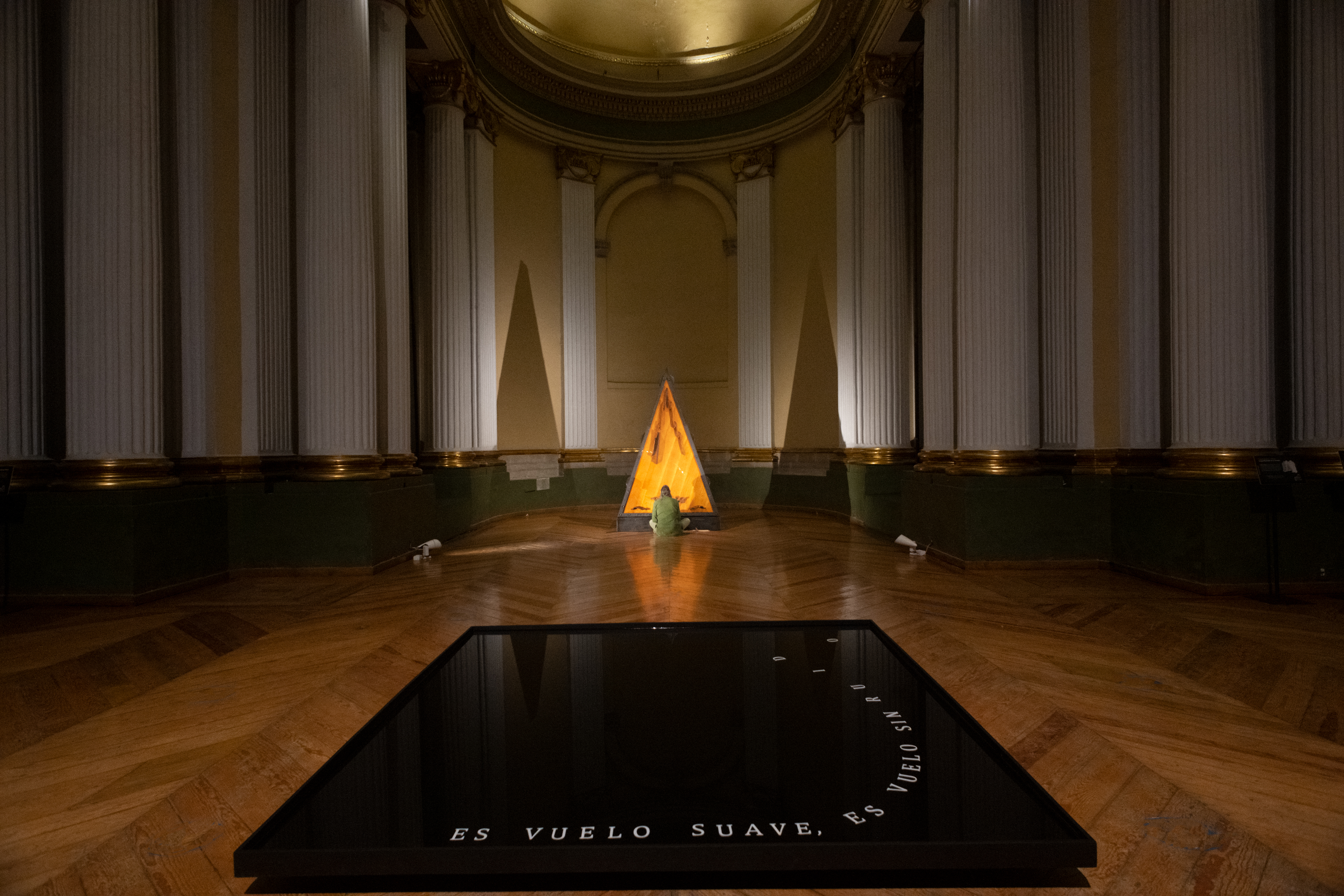
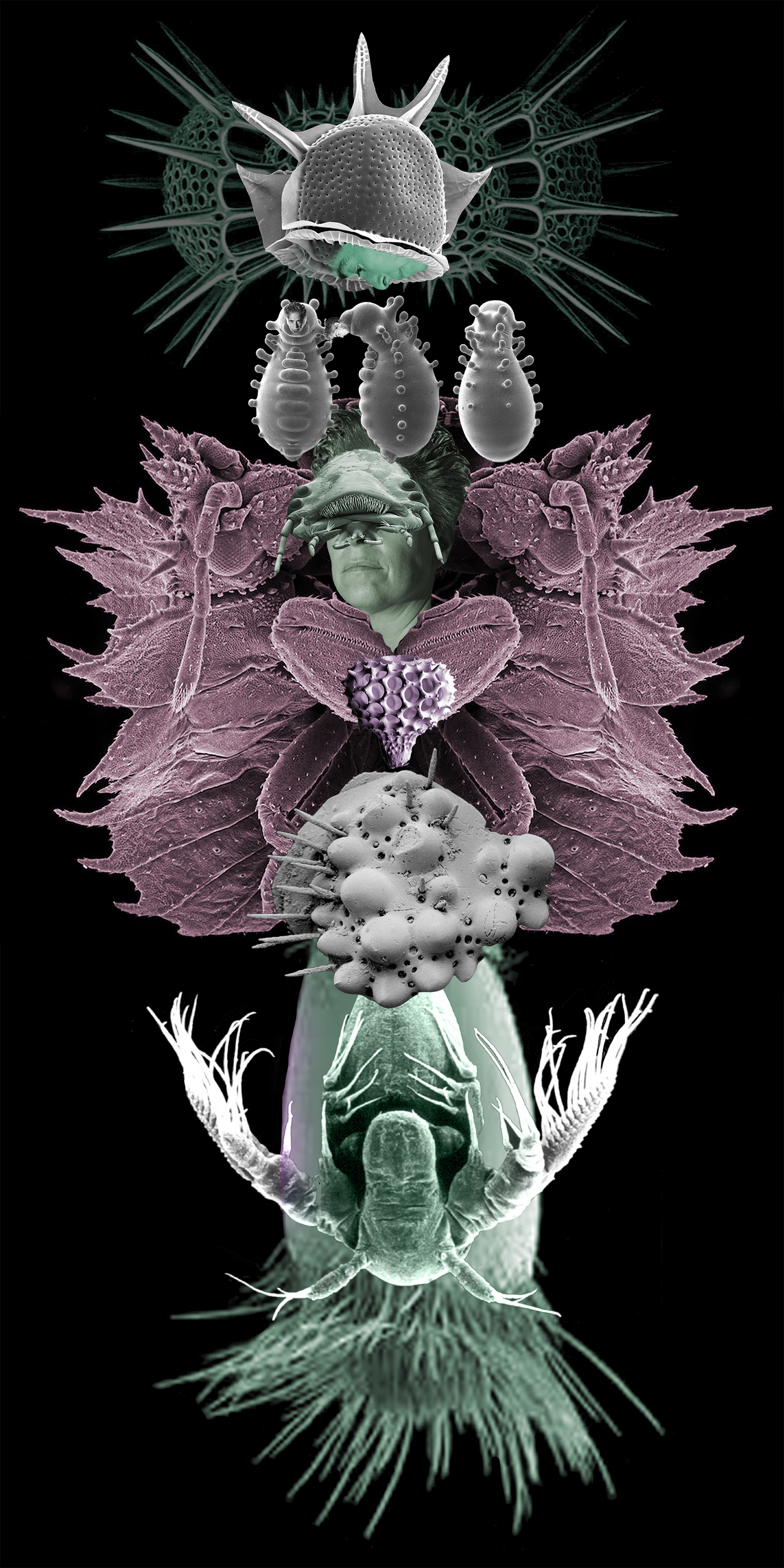
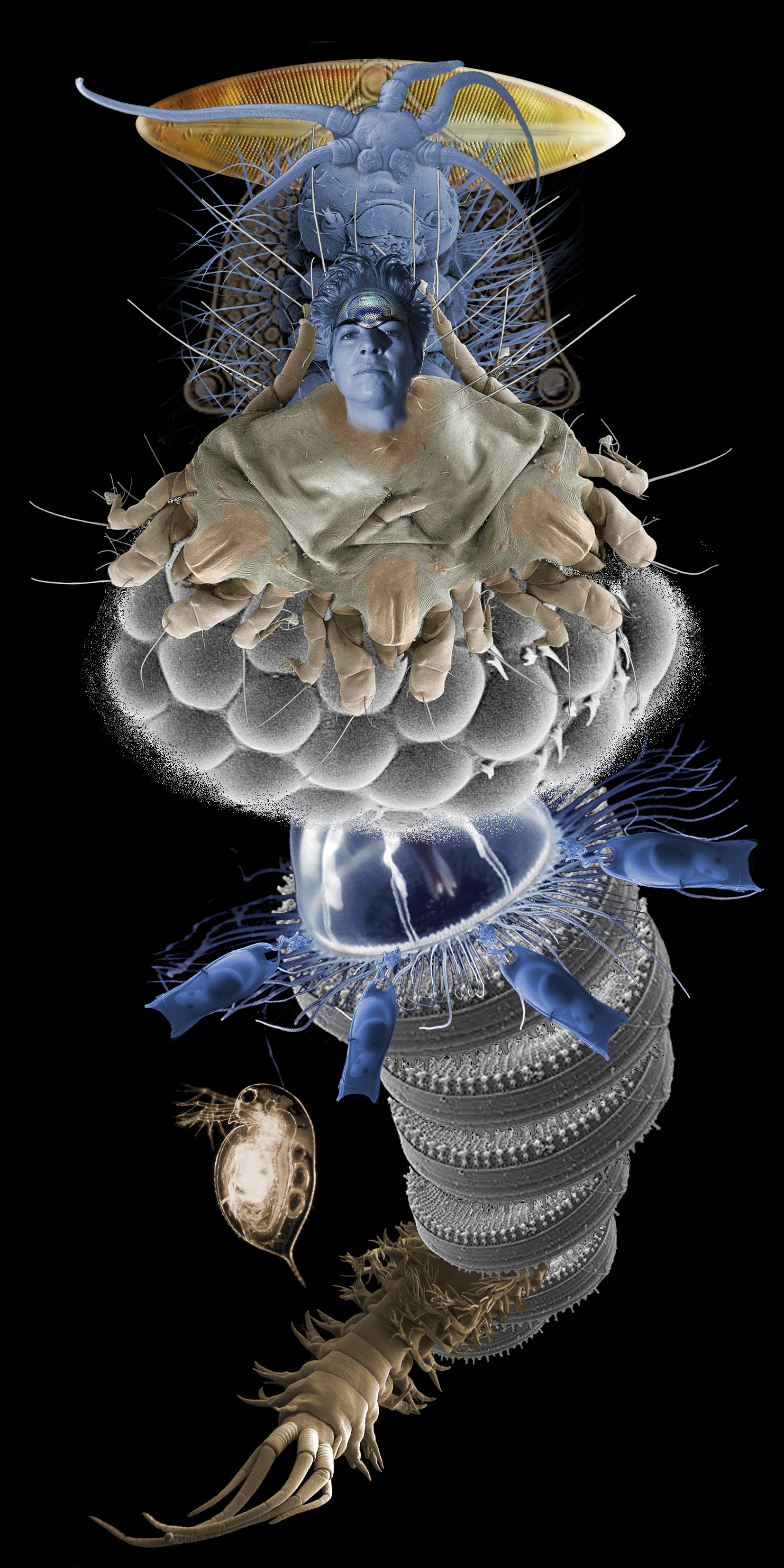
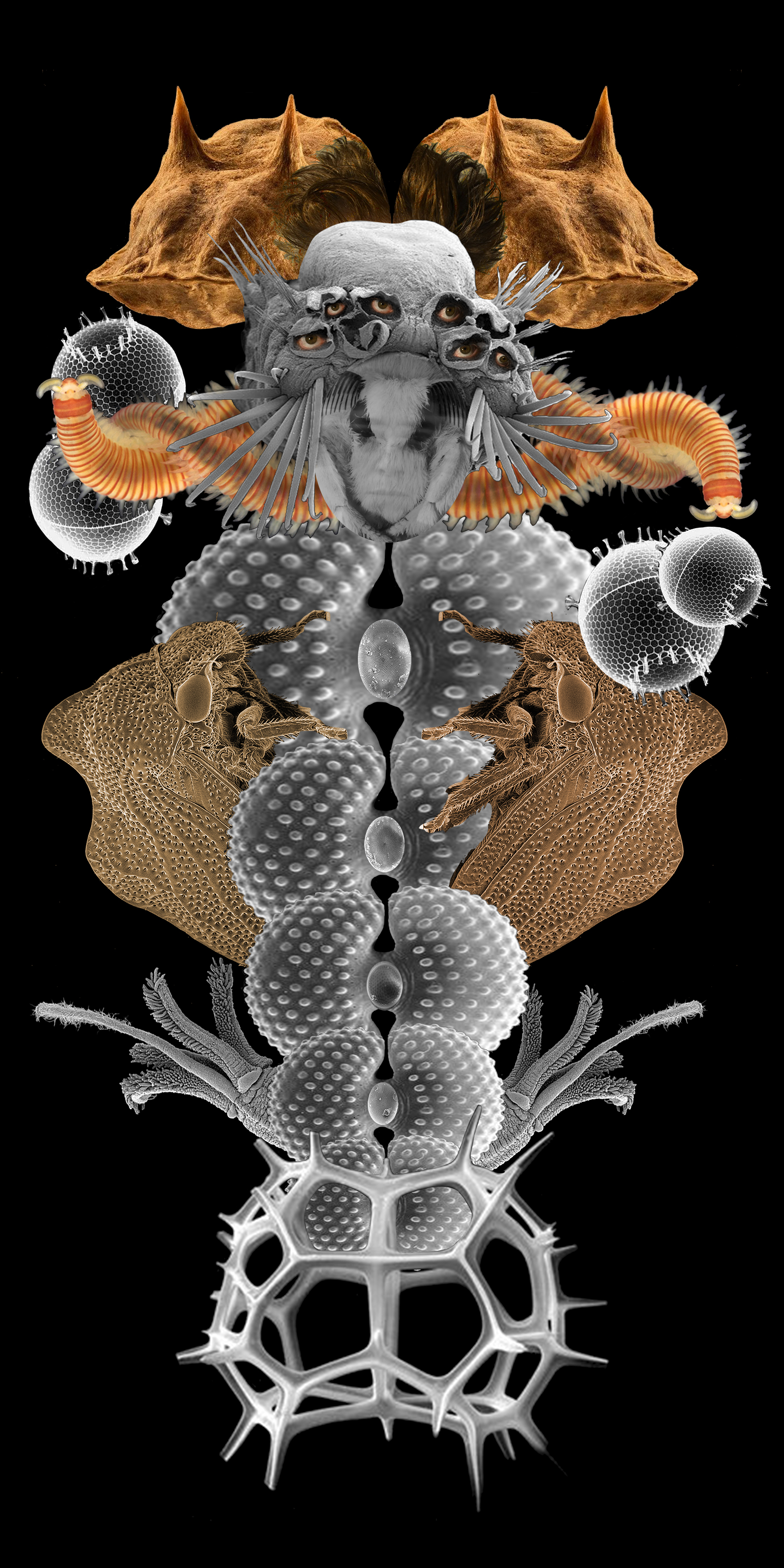
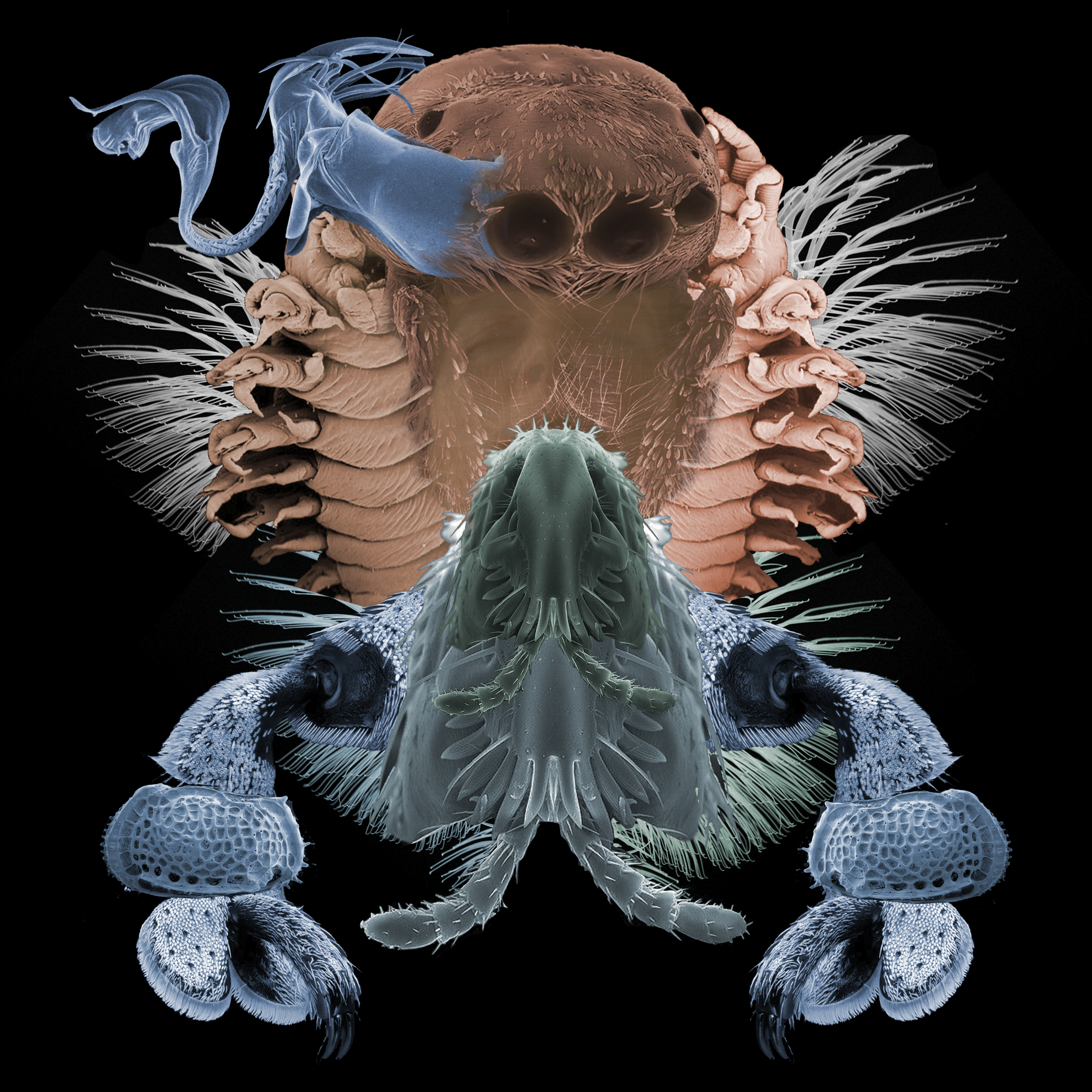
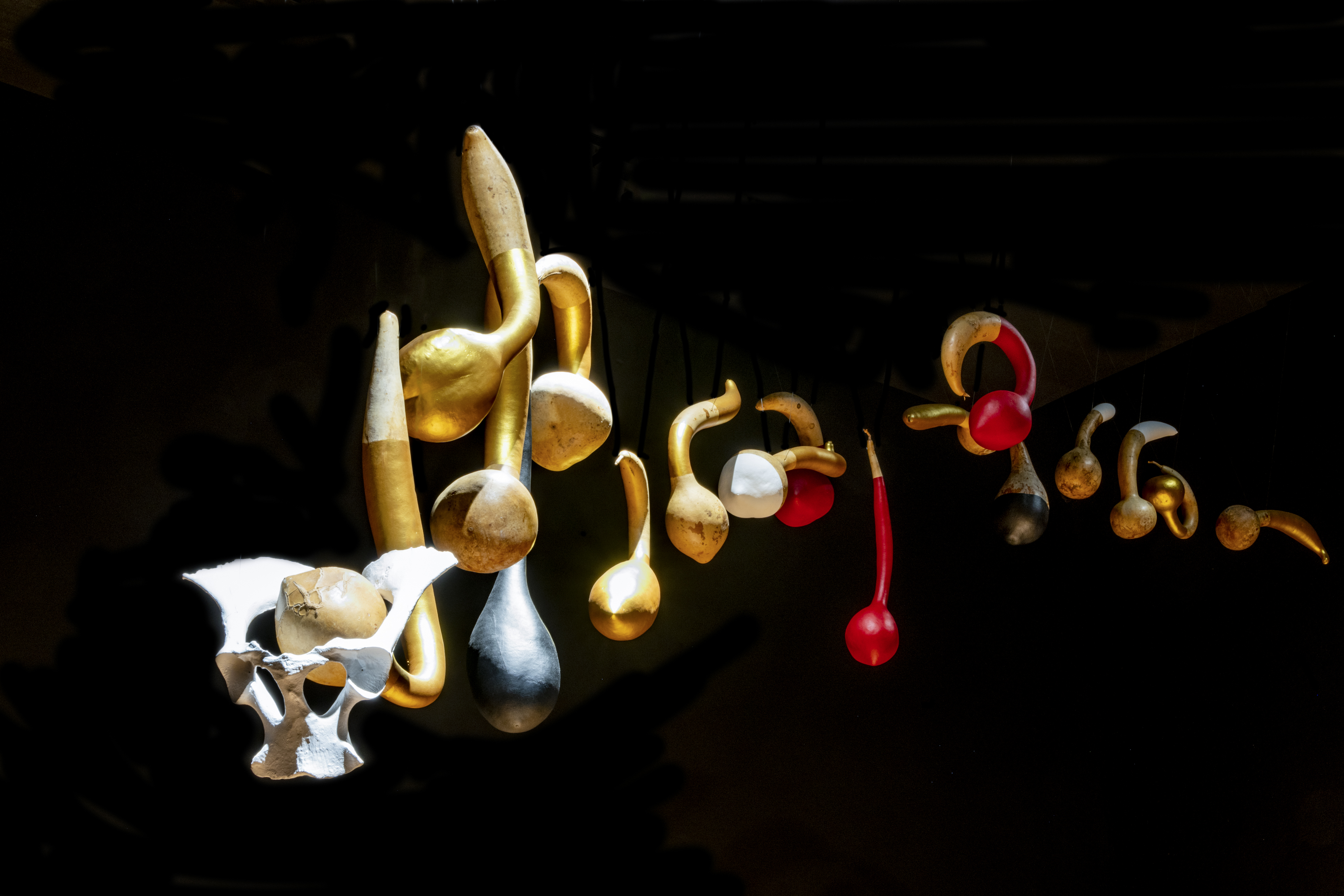
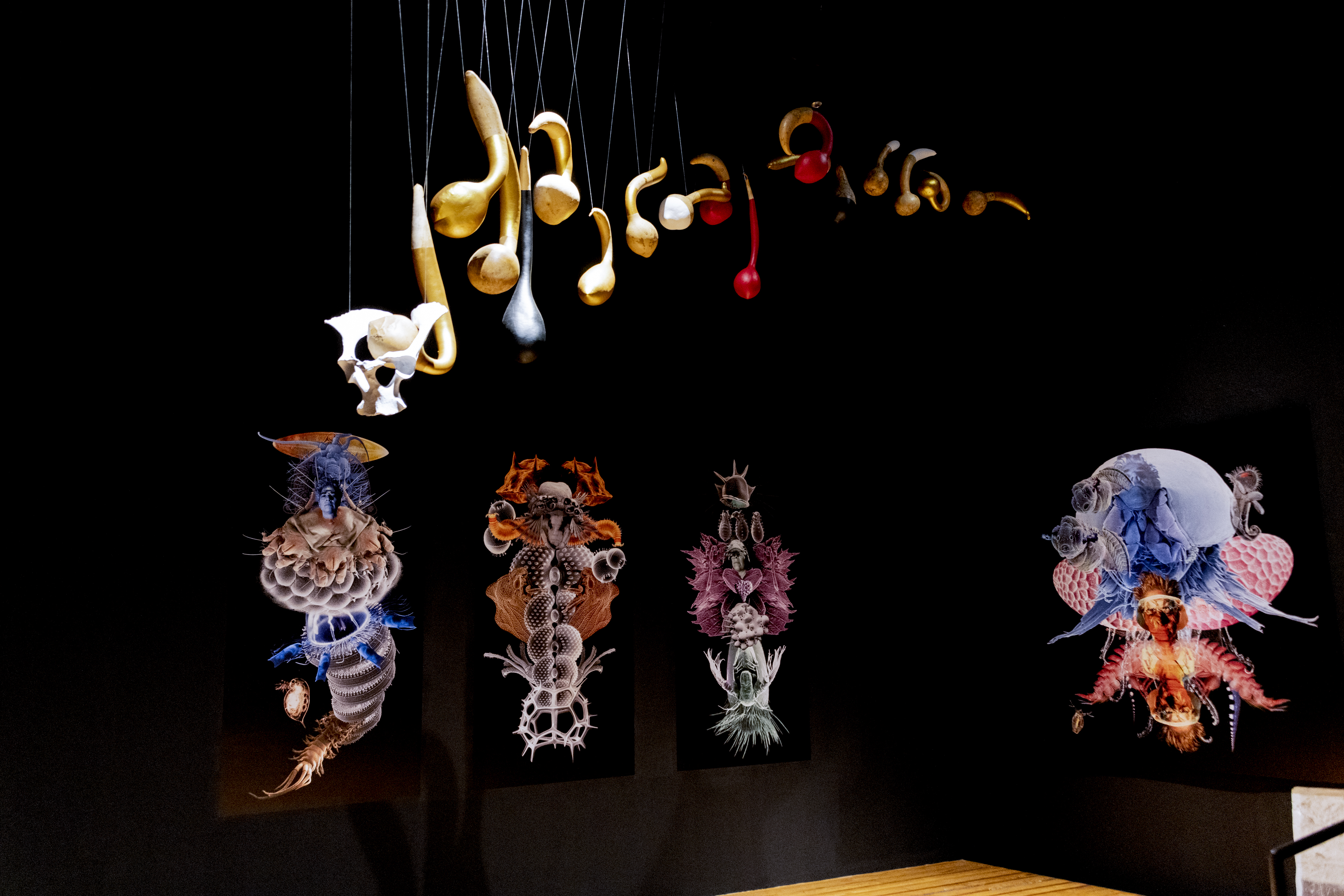
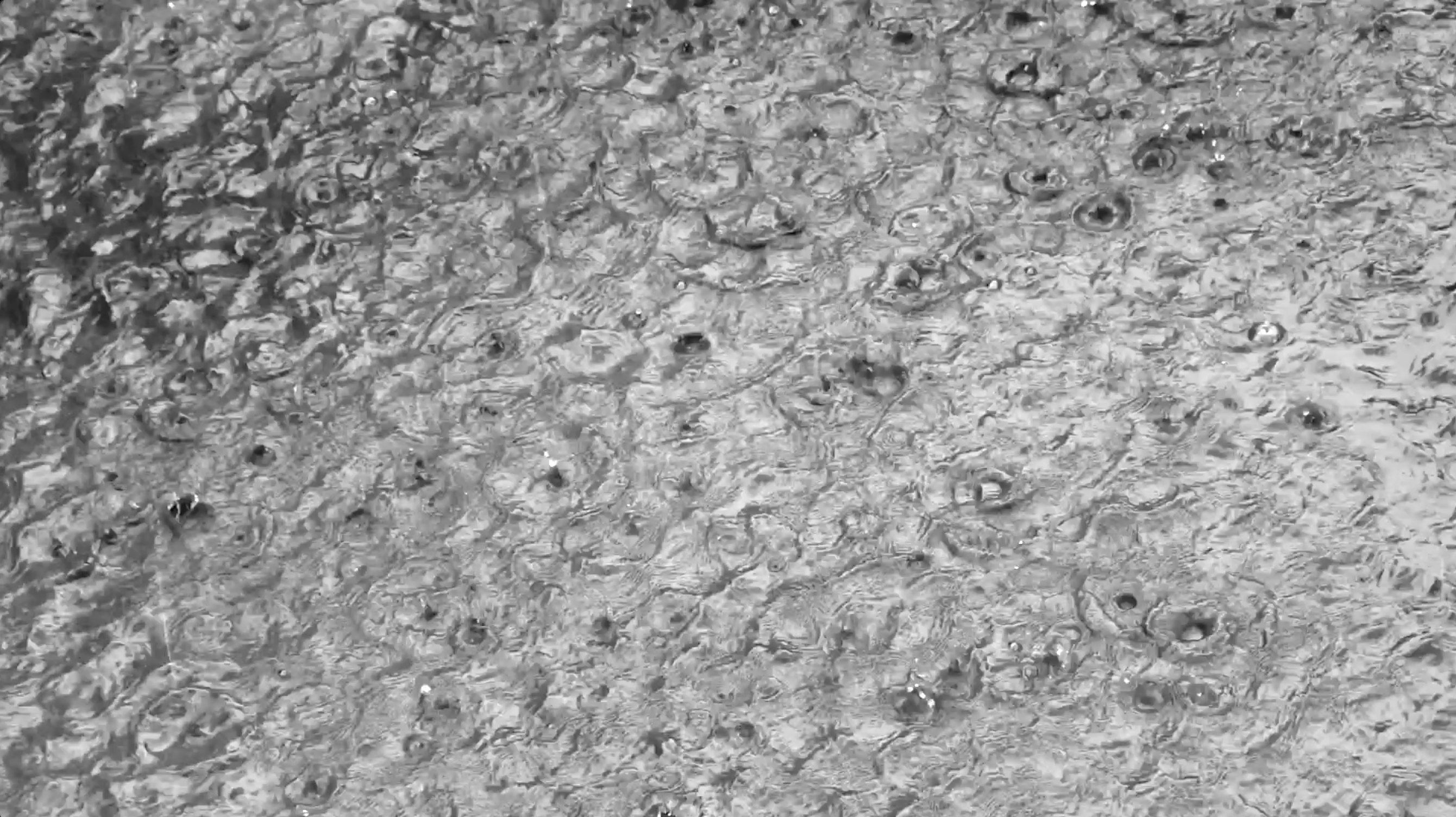
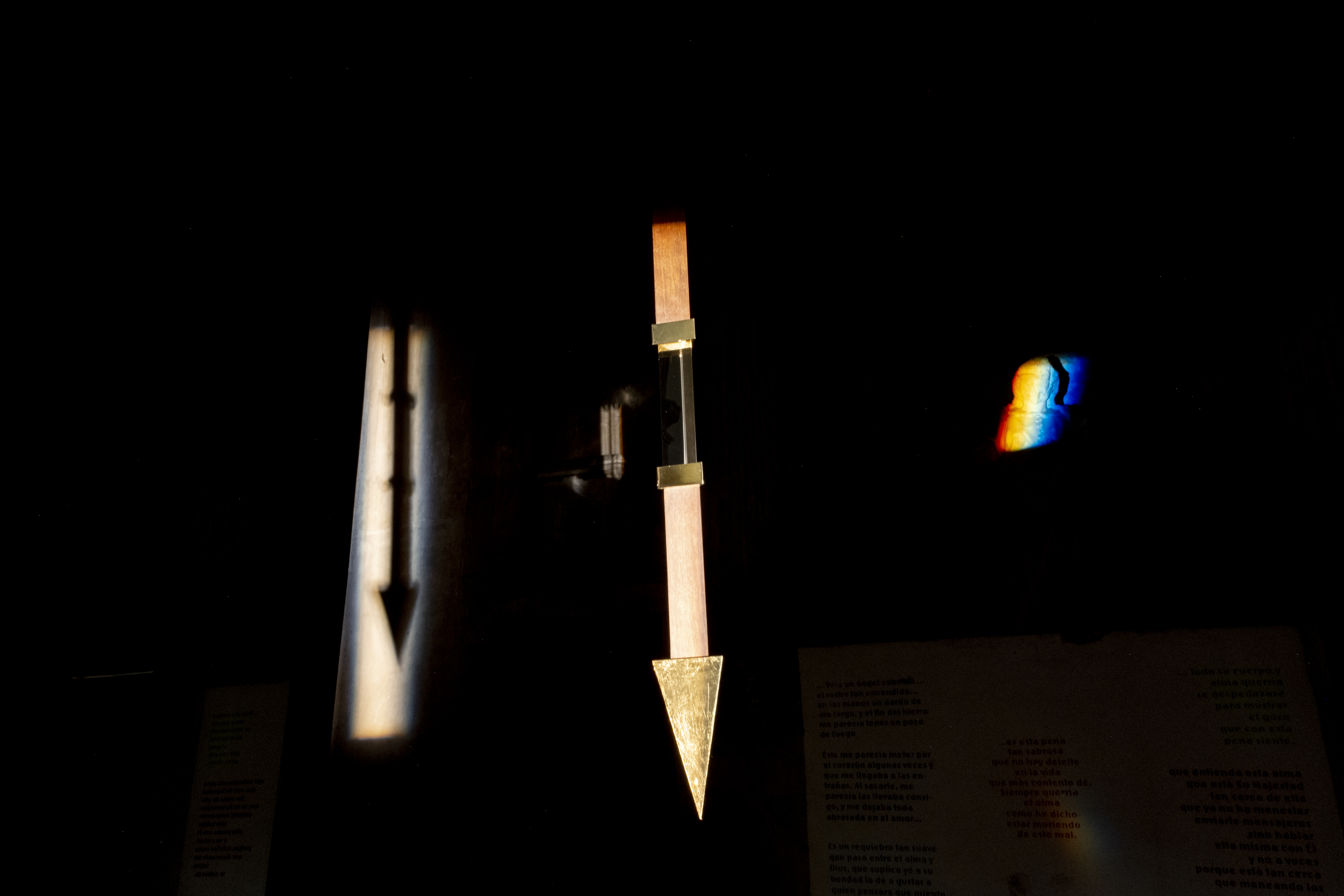
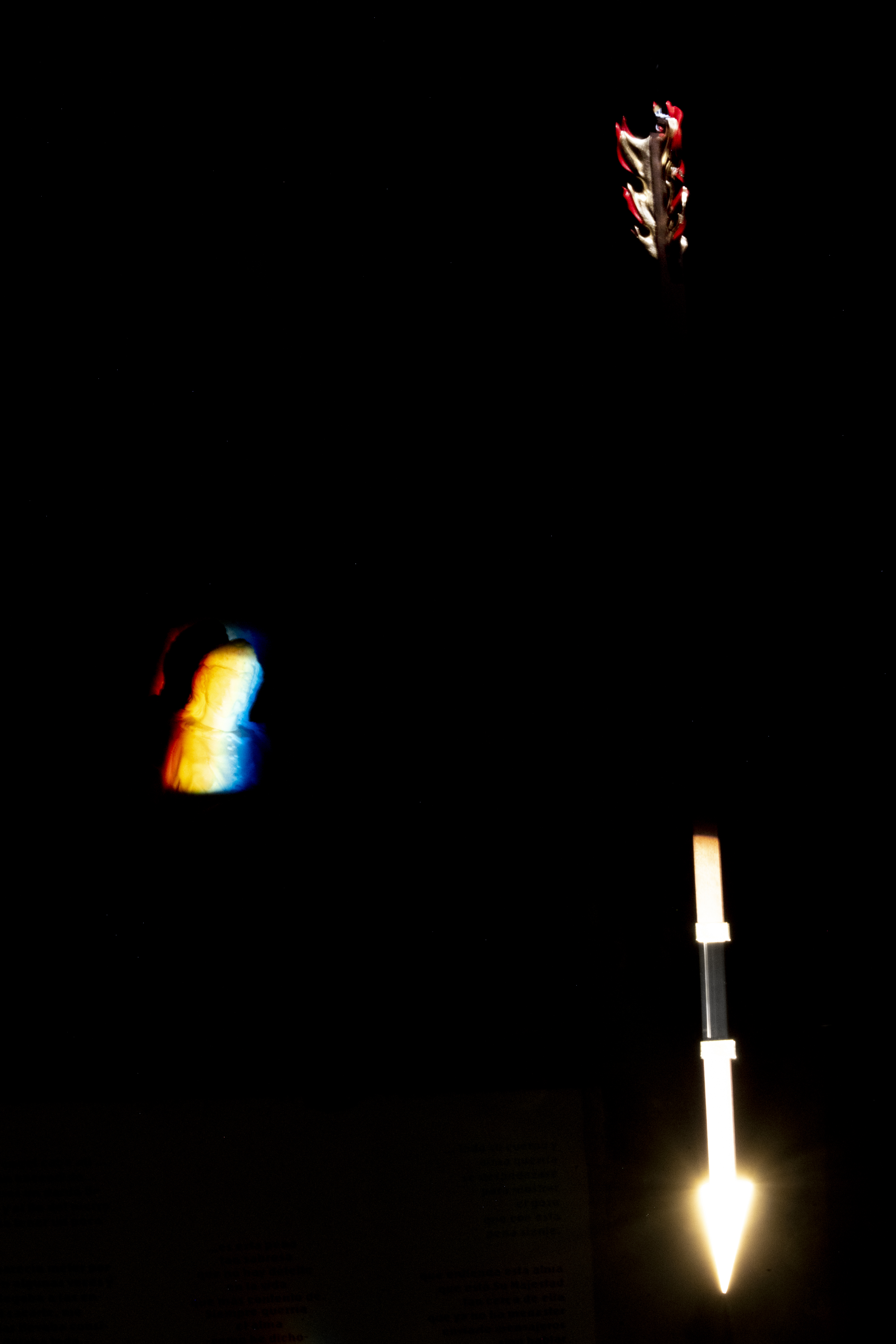
×
![]()
TRANSVERBERACIONES
Transverberations
Ximena Labra
Transverberations is a contemporary interpretation of the spiritual experiences described by Saint Teresa of Ávila, a 16th-century poet and mystic, to whom the former temple that houses this exhibition is dedicated.
Composed of a series of works created to converse with the architectural setting, the exhibition evokes elements mentioned in Teresian literature such as love, death, desire, the mundane and the sacred, suffering, ecstasy, and infinity. The works created expressly by Ximena Labra (Mexico City, 1972) weave a metaphorical universe in which the texts of Saint Teresa are transformed into the mythological delights and horrors of our era: cinematographic references, images from scanning electron microscopes, geometries and numbers, sound instruments, monuments and timeless rituals.
The title of the exhibition comes from the Latin term "transverberatio" which literally means "to go through", referring to the mystical experience described by the saint in which her heart was pierced by a supernatural fire. Based on this idea, Labra proposes a transformed, transverberated space that evokes prodigious narratives withn an immersive journey in which Teresian poetry materializes in sculptural, visual and sound installations.
In this project, the imaginary universe of Ximena Labra links concepts from various Asian traditions with the transcendent aspect of Teresa. The idea of transmutation dialogues with the possibility of looking our own demons and virtues in the eye in the everyday universe.
Transveberations also evokes the exceptional qualities of Teresa of Ávila, born in 1515, recognized as a living saint and author of several literary masterpieces, who for centuries was denied the title of Doctor by the Pope because she was a woman. In 1922, the Faculty of the University of Salamanca, in the session of March 4 presided over by Miguel de Unamuno, agreed by acclamation to grant her the Doctorate Honoris Causa. The Saint was thus the first Doctor Honoris Causa in history.
Pieces
1 Disolution -Manifestation, 2022.Walk through painting.
Acrylic over canvas. 5 suspended banners painted on both sides.
9.40 x 9 m
This walk through painting is composed of two faces: Dissolution, with a 9 m shark emerging from tthe cosmos represents the death of the seas, destruction, transmutation, and the formless absolute known in Indian traditions as Shiva. Manifestation, on the other side, is a geometric representation of the universe known as a yantra representing Shiva's counterpart, the Goddess who manifests the universe. The author establishes a dialogue between the idea of death —which for Saint Teresa is transcendence, the promise of Heaven— with the Hindu idea that the universal manifestation comes from the void: an object of contemplation (the yantra) in which the meditator, the meditation and the object become one.
2 Throne (Jejuri), 2022 Construction. 2500 bricks- painted with turmeric, lighting. 18 x 3 x 1.50 m
Jejuri is an intervention in the central nave of the former St. Teresa temple that on the one hand evokes the golden temple of Jejuri, dedicated to Kandhoba, a deity known for granting wishes; and on the other the sacred thrones from which Buddhist masters impart knowledge. It also alludes to the inner throne of God, which for Saint Teresa is the place of the seventh dwelling, the essence of the heart. The long corridor painted in turmeric is also reminiscent of the yellow brick road followed by Dorothy in the 1939 Hollywood film "The Wizard of Oz". The throne at the end of the path is the ideal place from which the geometric Manifestation of the absolute, represented by the yantra can be observed.
3 Colloquiums, 2022 12 graphite rubbings over cotton.
2.20 x 1.18 m
This piece reproduces the first 12 pages of "Coloquios", a 1524 manuscript that transcribes the first colloquium between Tenochca priests and Franciscan friars in “New Spain”, where two very different worldviews were confronted. The transcription in Nahuatl and Spanish of this meeting was found in Tlatelolco around 1564 by Friar Bernardino de Sahagún, who transcribed it with the help of experts in both languages and traditions with the purpose of publishing it, but the manuscript disappeared, only to be rediscovered by the Franciscan Pascual Saura around 1920 in the Vatican Secret Archives. The document, seriously truncated, no longer has the 30 chapters of the first book that are listed in the prologue, but only the first 13 in Spanish and 14 in Nahuatl. It is probable that in the section that was torn out there were authentic dissertations of the indigenous priests, and this prevented its publication due to the uprooting plan established in Mexico by the Inquisition.
4 Nice Moronga (Blood), 2022 floating wooden arch and fiberglass drop.
80 x 20 cm, 3.50 x 1m
Both prehispanic and Christian altars have traditionaly been adorned with human blood for centuries.
5 Es vuelo suave, es vuelo sin ruido / It´s a soft flight, a noisless flight, 2022
Water mirror. 28 characters, lead with white enamel, fiberglass. 2.80 x 2.80 x 8 m.
Teresian quotation, Book of Life. With this phrase Teresa describes her own spiritual experience of prayer and meditation.
6 Citrapataṃga Brevicornis, 2022.
Concept: Ximena Labra, Leonardo Heiblum. Colaboration with luthier Carlos Chinchillas.
Musical instrument for ten hands, sound sculpture. Landscape instrument. Harmonic table: cedar wood with carved chagane wood bridges. 108 strings: piano, concert harp, Jarocha harp, jarana, sitar and psaltery strings. Body: chechen and katalox woods. Iron and steel.
2.7 x 1.8 x 1.3 m
Citrapataṃga: from the Sanskrit language, butterfly.
Pataṃga: any animal that flies.
Citra: image or representation, the multicolored, the varied and brilliant, the splendid. It can also refer to clear and perceptible sounds.
Brevicornis: Baronia Brevicornis is the oldest butterfly on the planet, 70 million years old. It lives only on the plant that grows in Mexico called Acacia cochiacantha.
Citrapatamga emits a universal sound principle that, depending on its frequency, is perceived aurally and bodily through its vibration. The instrument is inspired by the frequencies of visible colors, so its harmonic arrangement starts from the fundamental note fa#, which is the lowest and highest frequency of the octave of color visible to the human eye. The triangular shape represents the masculine and the feminine and replicates the geometric figure of the yantra, both ascending and descending, since it can be played in two positions, vertical and horizontal. It also evokes a seated human body with its various nadis or channels of ascending and descending energy, drawn by six groups of resonant strings that cross the surface of the object.
7 Gunas, 2022
Hanging Sculpture. Pelvis and painted dried squashes.
4.50 x .5 m. Aprox.
The material universe is said to be composed of three types of energy: Satva, the pure energy; rajas, the activity that goes from the pure to the impure; and tamas, inertia and negativity. The three form a thread with which the universe that we perceive is woven, so that we arte constantly going through these three states, known as gunas. At the head of the gunas is always the certainty of death.
8 Caterpillars, 2022
Digital collage from electron microscope images. Vinyl or photo prints, series of 5. 2 x 1, 2 x 2 m.
The caterpillar series is about the beastly and beautiful process of transformation. Saint Teresa describes the human soul as a butterfly. The caterpillar represents for her the internal enemies, the demonic —for us the ego— in the understanding that for the butterfly to be able to fly, the caterpillar has to die.
9 Nada te turbe. 2022 / Nothing distrurb you
Teresian quotation. Colored vynil, variable size. Nada te Turbe is the quintessential teresian teaching.
9 Prayer, 2022
Soundscape: A walk around the temple in Bodgaya, India. Tumbonas/ Deck chairs. Video, 43min, visible on an independent enttry on this webiste as "ORACION/PRAYER"
Mahabodi is the temple known as the place where the Buddha became enlightened. Bodhgaya, where it is located, is said to be the navel of the world and no other place on earth could bear the weight of the Buddha's merits. It is a place of pilgrimage where a large number of people gather in continuous prayer. As the ritual of circumambulating the temple is carried out, prayers are heard in multiple Asian languages, a soundscape of sacred conversations.
Teresa considered the continuous conversation with God as her fundamental practice. In her writings, water –represented here as an image to rest the eyes while listening to the landscape– is a fundamental sacred element that represents divine grace. (John 4:11 da mihi aquam)
10 Transverberation, 2022
Installation. 2 mirrors, walnut arrow with a crystal prism, brass and gold leaf, vinyl quotations from St Teresa of Avila, lighting.
This intervention is about ecstasy and infinity. Floating from the ceiling hangs an arrow that symbolizes a “transverberation”: the mystical experience of the heart pierced by a supernatural fire that
Teresa describes in her book of life. From the arrow a rainbow emerges, illuminating a probable Saint Joseph existing in this chapel, the Teresa's patron and protector. The vision of the luminous spectrum is also inspired by the experiments on the nature of light and colors carried out during a pandemic by Isaac Newton that he later published in his treatise Opticks, published in 1704.